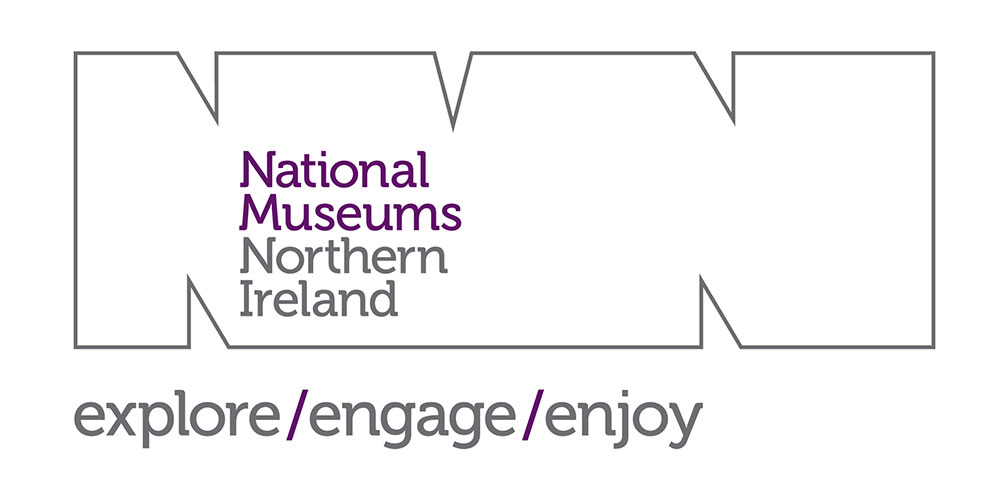Lowland Sources of Ulster-Scots: Gregg and The Linguistic Atlas of Scotland (volume 3) Compared
Caroline Macafee
Robert Gregg's work on the dialect boundaries of Ulster-Scots has become one of the pillars of research in this field. His map of the boundaries has been much reprinted, and is known to many people who are not familiar with the extensive research on which it was based.(1)
Gregg conducted his fieldwork between 1960 and 1963, only a few years after the completion of fieldwork by the Linguistic Survey of Scotland. When he published his thesis in 1985,(2) Gregg was already aware of some of the preliminary findings of the Survey, but the results were not published until the following year, as volume 3 of The Linguistic Atlas of Scotland (LAS3).(3) Until now, no comparison has been made between the two studies. Of course, LAS3 can have little to add to Gregg's coverage of Ulster-Scots, since its selection of localities is much smaller, and confined to East Ulster. There are actually only eight localities in LAS3 that represent Ulster-Scots (Down 1-4, Antrim 2-5). The other Ulster localities are clearly Hiberno-English. (As in Gregg, the dividing line is quite abrupt, though not, of course, absolute.) The main interest of the LAS3 data for us lies in the possibility of exploring connections between Ulster dialects and their Lowland Scots sources. In this paper, I concentrate on the phonemic level of analysis, including lexical incidence. A more phonetic treatment can be found in the work of Johnston, but, like Milroy, Johnston does not always confine his description of East Ulster speech to Ulster-Scots as understood by Gregg and followed here.(4) (This conflation of the two varieties leads to a possible misinterpretation, as discussed below.)
A note on the presentation of the LAS3 data may be helpful. The 'polyphonemes' (see Table 1) are no more than large chunks of phonetic space, and information is simply lost by grouping the data in this way. Polyphoneme E in particular covers four historical phonemes, and the maps which show how many 'phonemes' occur in E (environment by environment) do not clarify which ones occur. In word maps, two or more different phonemes can be shown as the same; or the same phoneme can be shown as different polyphonemes in different places.(5)
As Johnston points out, the LAS3 'phonemes', which are not aggregated across phonetic environments, are too numerous to fit in with our understanding of the phonemic system of Scots vowels. Fortunately, the data are given in detail, though some doubts have been expressed about accuracy (especially with regard to vowel length) and missing localities.6
Dialect Divisions of Lowland and Insular Scots
Map 1 shows the dialect divisions of Lowland Scots. The dialects of Lowland Scots were originally mapped by Murray,(7) and modified by Grant (8) (though Ulster-Scots had to wait for Gregg). Johnston's revision based on LAS3 shows for instance that Southern and South-West Scots are being encroached upon by Central dialects.(9) However, these recent developments do not concern us here, and I have simply reproduced the well-known map in the form given in CSD (which renames some of the dialect areas), although Johnston's map may, in some ways, be more accurate even for earlier periods, as the traditional map sometimes resorts merely to following county boundaries. For the same reasons, I have not followed Aitken in incorporating Speitel's revision of the Highland Line, which shows the possibly recent phenomenon of Scots retreating eastwards, although it also gives a more accurate treatment of largely uninhabited areas.(10)
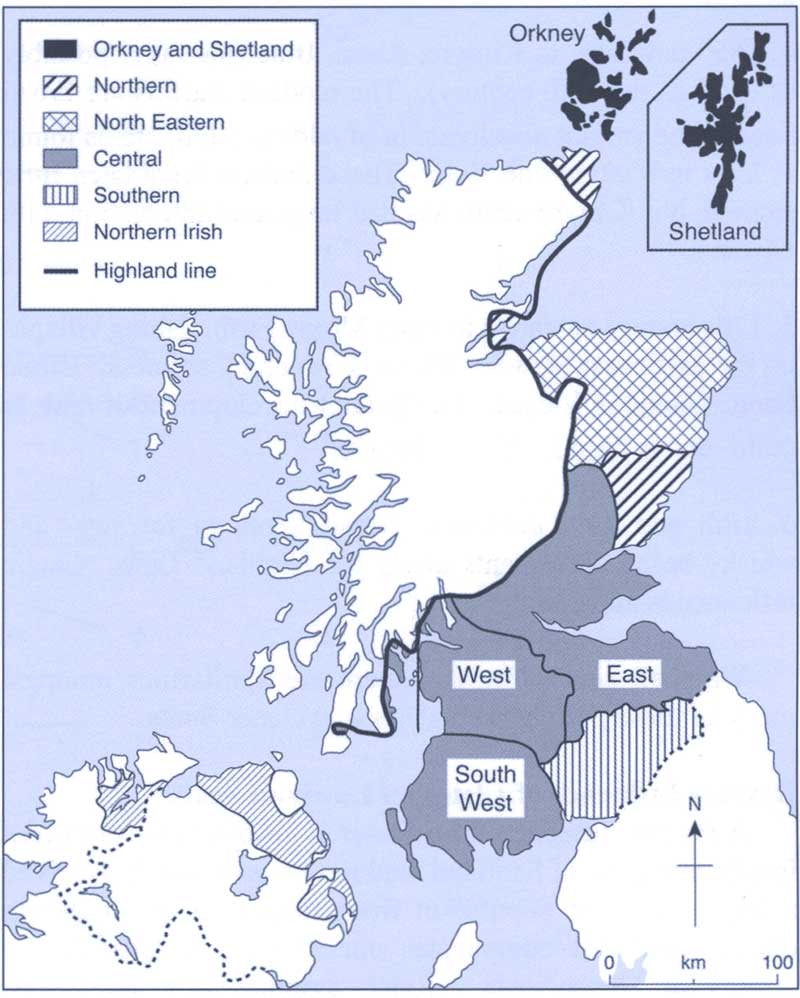
Map 1: the main dialect divisions of Scots (based on CSD, Map 1, and Gregg, 1985, Part II, Map 1), by kind permission of Scottish Language Dictionaries Ltd. and Mrs. Gregg
It is as well to remember that the dialect divisions shown in Map 1 relate to a period two and a half centuries later than the Scots settlement of Ulster.
The Spread of Scots in Scotland and Ulster
It is interesting to place Ulster within the context of the spread of Scots within Scotland, as it reminds us that some Lowland dialects were formed later than Ulster-Scots. The chronology below is based on the work of Speitel and Mather.(11)
1. 15th century: Caithness (modest influx from the 13th century on); Orkney and Shetland (ceded to Scotland from Denmark in 1486, with a modest influx previously, particularly in Orkney). The modern dialects are broad Scots. There is a variant development of /ald/ to /ʌuld/ 'old', etc., discussed below. A striking archaism is incomplete l-vocalisation (/al/ 'all', etc.). There is considerable Norn influence on vocabulary and phonology. The islands were never Gaelic-speaking, but Caithness shows Gaelic influence.
2. 16th century: presumed demise of Gaelic in the Southwest. Long-term interaction with Ulster makes it difficult to determine the direction of influence and to separate Scottish Gaelic from Irish influence.
3. 1603 onwards: spread to county Antrim, county Down, county Donegal, later into county Londonderry. Nothing specific is known of the characteristics of the Medieval Anglo-Irish previously spoken in urban centres (Carrickfergus, Newry). The modern dialects are broad Scots, exhibiting dialect variation, some presumably from the point of creation.
4. 1650 onwards: to Kintyre, Arran, Bute (the latter possibly as early as the 15th century). The modern dialects are broad Scots. The variant development of /ald/ to /ʌuld/ etc. is found at least in Kintyre and Bute. These dialects have been little studied, but Kintyre again has had long-term interaction with Ulster.
5. 17th century onwards: to inner Moray Firth, fishing villages on the east coast between Moray Firth and Caithness. Broad Scots, Gaelic influence. The variant development of /ald/ to /ʌuld/ etc. is found.
6. 18th and 19th centuries: Broad Scots to forestry- and whisky-based settlements along the Highland Line. Gaelic influence is apparent.
We shall see below that there are similarities amongst many of these peripheral dialects and Ulster-Scots.
Reverse Influence of Ulster on Lowland Scots
A reverse influence from Ulster is always to be suspected in adjacent parts of Scotland, and in Glasgow, which received a large influx of population from Ireland in the mid-19th century, and this complicates our attempts to identify the origins of Ulster-Scots. Riach assumes that similarities (lexical in his study) between Ulster and Galloway (South-West Scots) reflect seasonal migration from Ulster,(12) but Milroy takes the more reasonable view that in general:
Galloway Scots is itself probably the basis of much of Ulster-Scots (especially in county Down); therefore the influence goes from Scotland to Ulster .... .(13)
This does not, of course, preclude influence in the other direction. Certainly of Ulster origin is Glasgow youse (plural of you), and perhaps also wan 'one' (but see discussion below). Also apparently an Ulster importation is West Central lowering of /er/ to /ɛr/; Macafee has some slight support for its association with Catholic speech in Glasgow (14) — and occasional stopping of /θ, ð/ in Glasgow (also associated with Anglo-Irish influence in Liverpool).(15)
Vowel Phonology
To refer to the vowels, I shall use Aitken's numbering system (see Table 1).(16) Readers not accustomed to this system will probably find it necessary to make frequent reference to the table.
Vowel length in Modern Scots is governed by the Scottish Vowel-Length Rule (SVLR), sometimes called Aitken's Law. This is the outcome of a series of shortenings in all environments except morpheme-finally, before /r/ and before voiced fricatives. The powerful influence of this environment extends to the splits of Vowels 1 and 7 (see below). The originally close short Vowels 15 /ɪ/ and 19 /ʌ/ are unaffected (presumably showing little allophonic length variation to begin with), and where Vowels 8 and 12 remain distinct they are long in all environments. Otherwise the long vowels have lost distinctive length, and both originally long and short vowels show allophonic variation in the environments specified, particularly in the final syllable of a word, with various exceptions in peripheral dialects.(17) So the following contrast:
beat: tea
greed: agreed
beat: beer
leaf: weave
baith 'both': bathe
race: raise
leash: /pliʒɪr/ 'pleasure'
The early date of the SVLR is shown by the fact that it has spread (not always in its fullest form) throughout the Scots area, including Insular and Ulster-Scots, and also into Mid Ulster English.(18) Aitken cites definite evidence for its establishment before c. 1560.(19)
Vowel 1, primarily from OE ī, is split in Modern Scots into a diphthong with a short, centralised, half-open starting point (an earlier stage in development), variously represented as /əi, ʌi/, e.g. Fife ; and a diphthong with a half-long, open starting point, variously represented as /aɪ, a·e, ae/ e.g. five. The split is determined by the environments of the SVLR. The distinction is phonemic in Scots, because Vowel 1 short also contains the reflexes of Older Scots Vowel 8 word-finally (Vowel 8a), e.g. pey 'pay'. An example of a minimal pair is pey and pie.
Gregg describes additional phonological and morphological constraints on the occurrence of the lengthened /aw/ variant in Ulster.(20)
In Central dialects of Scots, Vowel 3 (from OE ǣ etc.) mostly falls together with Vowel 2, e.g. meat (as in Standard English), but Wigtownshire has /e/ as in Hiberno-English, as has Ulster-Scots in some words. There is no shortening before /d/ (as in English head), so this includes e.g. heid 'head' and also deif 'deaf'.
Table 1: Vowel systems of Scots: a rough historical outline, based on the following sources: Aitken (1977), Table 1; †Aitken (2002)
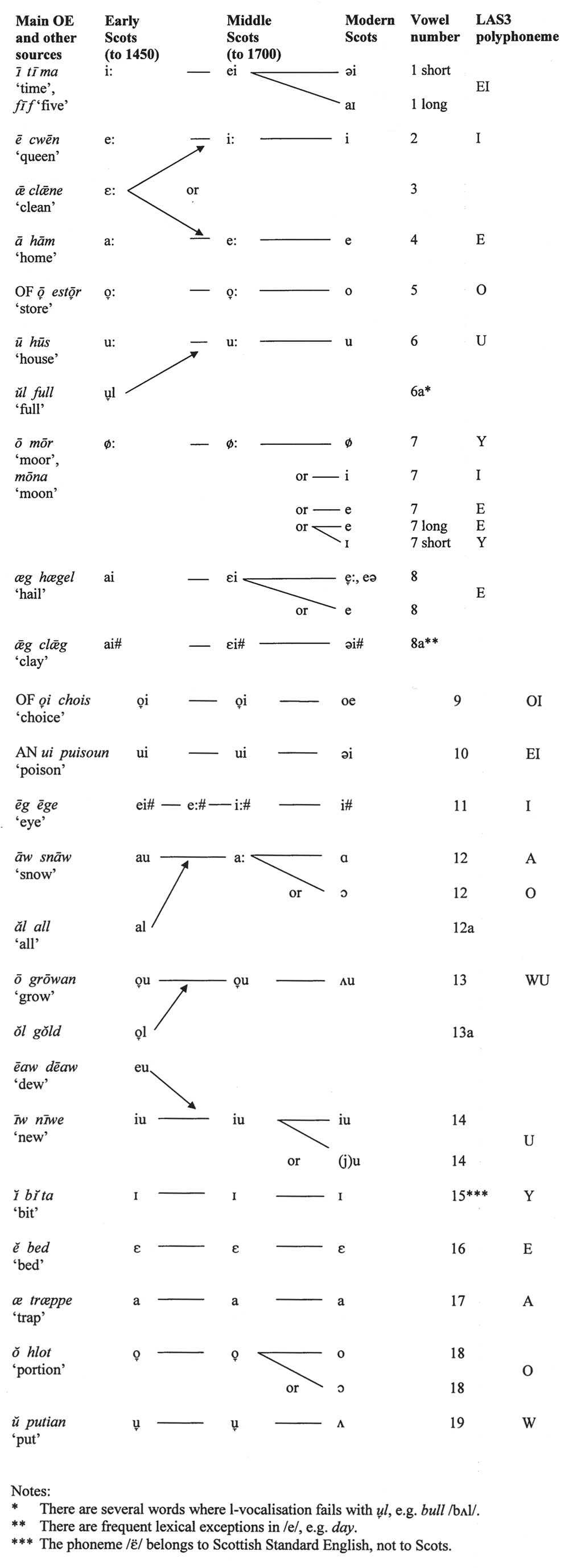
Vowel 4, OE ā, did not raise and round prior to the Great Vowel Shift (as in modern English south of the Humber), but has developed as a front vowel, merged with the reflex of OE æ by Open Syllable Lengthening, and consequently has a large functional load (e.g. gait 'goat', hame 'home', as well as, e.g. face, name).
The load of Vowel 5 is correspondingly small, consisting mainly of French loans, e.g. store, noble. It has usually merged with Vowel 18. However, the two vowels remain separate in Ulster-Scots. From this and other dialects which retain the distinction, it appears that before /r/ Scots lengthened Vowel 18 to merge with Vowel 5 rather than vice versa. (21)
Vowel 6 (from OE ū etc.) did not diphthongise by the Great Vowel Shift, and is still a close back or centralised monophthong. The load of Vowel 13 is correspondingly small, consisting mainly of OE ōw- e.g. growe 'grow'.
Vowel 7 from OE ō fronted north of the Humber prior to the Great Vowel Shift, thus e.g. guse 'goose'. Non-final OF ǖ also falls in with this, e.g. use. A number of words, including foot, are captured by Vowel 15 (see below) and there are special developments before voiceless velars (see below). It remains a front rounded vowel only in the most conservative dialects of Modern Scots, now mainly Shetland and Orkney. In the North-East it has unrounded to merge with Vowel 2 /i/. There are also traces of this development in parts of the Southwest (and eastwards to the vicinity of Berwick on both sides of the Border).(22) See Map 2. The occurrence of /i/ for Vowel 7 in the South-West appears to have been overlooked until the Linguistic Survey of Scotland.(23) This is doubtless the source of this form in county Down and county Donegal (see Map 5 below).
Map 2: /i/ reflexes of Vowel 7 in the south of Scotland, based on LAS 3: Lists (cf. Maps W26, W66, W87, W97)
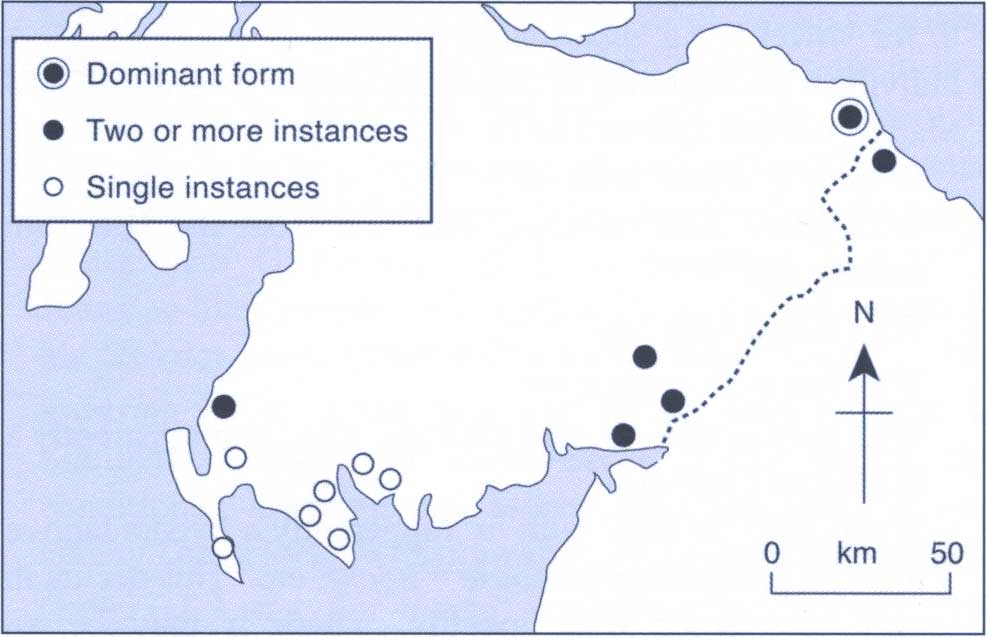
Notes: In tooth, /i/ is widespread (LAS3: Map W164).
The [ɛi] realisation in do and too at Spittal (Northumberland 2) also implies underlying final /i/.
In northern East Central Scots it has unrounded to merge with Vowel 4 /e/, which is found also in county Antrim (see Map 5 below). Elsewhere it has unrounded or is still unrounding to merge with Vowel 4 in the long environments of the SVLR (e.g. mair 'moor', yaize 'use' verb), and Vowel 15 in the short environments (e.g. gis 'goose', yis 'use' noun).
In a few dialects, including Ulster, the short reflex remains separate, and is a closer and more peripheral vowel than 15, nearer to RP. Hence Gregg's suggestion,(24) followed by Macafee,(25) that in the formation of Scottish Standard English, this separate Vowel 7 short was equated with English /ɪ/, while the original Scots Vowel 15 (which corresponds historically to /ɪ/) survives as the marginal phoneme /ɛ̈/ mainly in the environment of a following /r/, e.g. earth, or /v/, e.g. river with /ɪ/, never with /ɛ̈/, sever with /ɛ/.(26)
Vowel 12 comes from OE aw (e.g. claw) and also āw (e.g. snaw), and OF au (e.g. cause). The Modern Scots reflex is variously unrounded (Northern, Southern, South-West), in which case it may merge with Vowel 17, or rounded (Central Scots). Both occur in Ulster-Scots.
Vowel 4 in final position after /w, ʍ/, e.g. twae 'two', whae 'who', has been captured by Vowel 12 except in Southern and southern East Central, where it develops normally to /e/ (see LAS3 Maps W42, W44).
Vowel 12 also contains the reflex of Vowel 17 when vocalised before /l/ (around 1450, and not taken to Caithness, Orkney and Shetland), e.g. aw 'all'. Gregg shows /al/ in all etc. as an occasional form in East Ulster, and as the main reflex in most of Donegal, presumably a genuine archaism.(27) A following /d/ blocks the loss of /l/, e.g. auld 'old'. The variant development to ould (Vowel 13) will be discussed further below.
Map 3: merger of Vowel 18 with Vowel 12 as [ɒ]: nil phonemes in polyphoneme A (LAS3: Map S23 - © the estate of the late Hans Speitel, reproduced by kind permission of Pauline Cairns Speitel and James Mather)
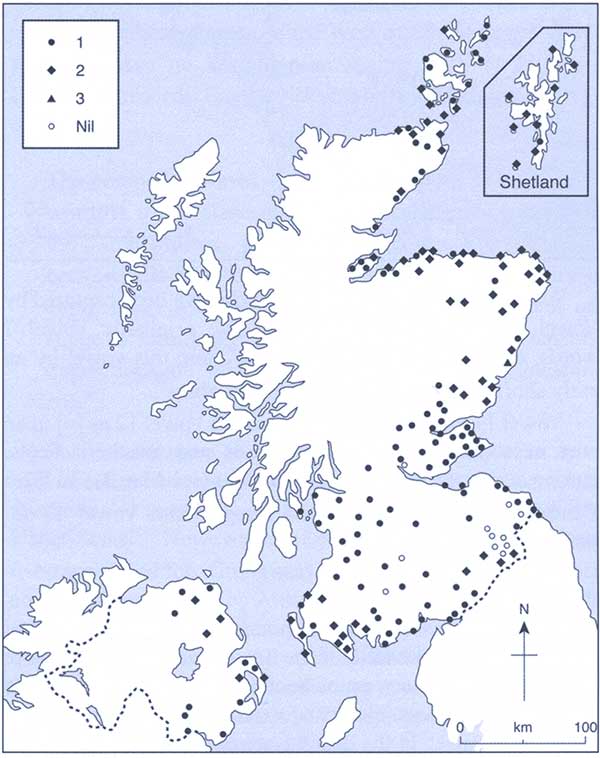
Note: Section 0 - the environment before /t/.
Vowel 14 remains separate in Southern Scots, but in most dialects has become /ju/, with consequent merger with Vowel 6 (e.g. dew, due), and loss of /j/ in some phonetic environments (e.g. true, blue). As well as OE ēow and word-final OF ǖ, it also contains, in some dialects, original Vowel 7 before voiceless velars, e.g. pleuch 'plough' and heuk 'hook'. But in other dialects (West Central, northern East Central, as well as Ulster-Scots) these have /jʌ/, i.e. Vowel 19.
Map 4: the foci of Scottish migration to Ulster (Perceval-Maxwell, 1973: Map 'The origins of the Scottish undertakers', by kind permission of Prof. Perceval-Maxwell)
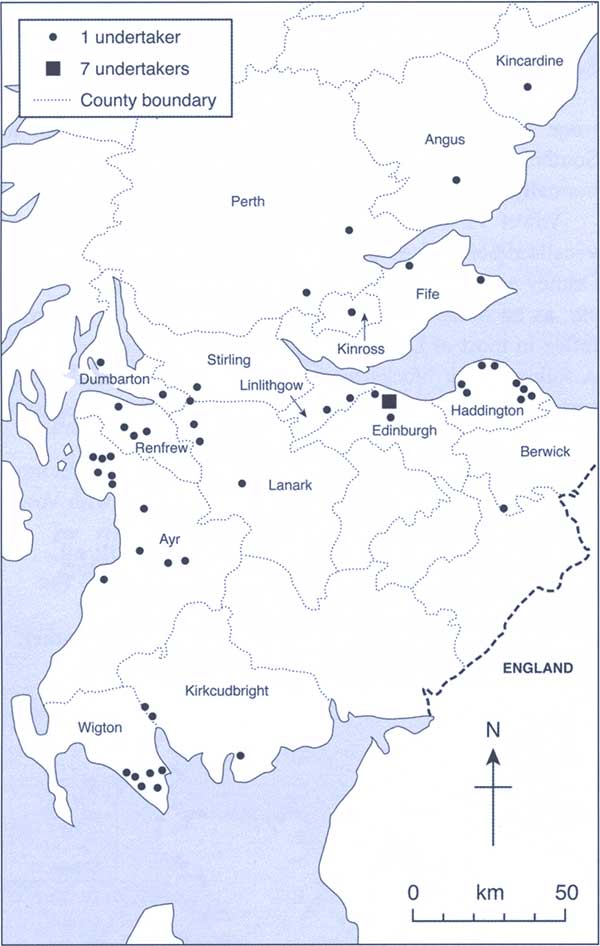
A small number of Vowel 19 words have been captured by Vowel 15, e.g. hinny 'honey'. Some originally Vowel 7 words, e.g. mither 'mother', fit 'foot', join this vowel by an early shortening to u, hence to /ɪ/ as in hinny.(28)
Vowel 17 has merged with a rounded Vowel 12 as [ɒ] in an area of southern East Central Scots and Southern Scots, cutting across the main dialect divisions (see Map 3). In West Central, there is a conditioned merger with Vowel 12 /ɔ/ before /r, rC, nd, l/.
Phonological Links
Ulster-Scots is, as Johnston points out, clearly a dialect of Central Scots.(29) The bulk of the Scots planters are known to have come from the west of Scotland (see Map 4), with the addition of lawless elements expelled from the Borders (Southern Scots). In the data we are examining here, there is little indication of an input from Southern Scots.
There is considerable regional variation within Ulster-Scots. Gregg mentions some features briefly, but concentrates mainly on mapping Scots forms in the aggregate against their English cognates, leaving much of his valuable data to speak for itself.(30)
In the present paper I compare Ulster-Scots and Lowland Scots in terms of the main differentiae of Scots dialect phonology (the splits, mergers and sound changes that affect large parts of the vocabulary), and also examine the LAS3 maps for peculiarities shared between Ulster-Scots and particular Lowland Scots dialects. (Constraints of time preclude a full examination of the LAS3 lists.) I have also examined the LAS3 data for evidence relevant to Gregg's interpretation of the distribution of long and short reflexes of Vowel 1 in Ulster-Scots.
Shared with Central Scots (Central includes South-West):
• merger of Vowel 3, e.g. cheat, with Vowel 2 as /i/ (except Wigtownshire)
• /jɪ/ for initial /e/ Vowel 4 as in yin 'one' (see LAS3 Map W144), coexisting in Ulster-Scots with wan
• West Central and South-West /ɔ, ɑ/ Vowel 12 after /w, ʍ/, e.g. twa 'two', awa 'away', as opposed to Southern Scots /e/ Vowel 4 (31)
• individual peculiarities of lexical incidence (based on LAS3 Maps, checked against Lists):
W10 wet with /a/, as opposed to weet elsewhere in Scots
W12 sat with /ʌ/
W85 drove (past tense of drive) with /ɪ/ (coexisting in West Central and South-West with usual Scots drave, and possibly representing an East Midland English form transmitted from Ulster)
W88 live with archaic /i/
W103 came (past tense of come) with /ʌ/.
Shared with South-West Scots:
• merger of Vowel 3, e.g. cheat, with Vowel 4 as /e/ in Wigtownshire
• /ɑ/ for Vowel 12, e.g. snow, all
• /i/ for Vowel 7, e.g. moor, moon
• individual peculiarities of lexical incidence (based on LAS3 Maps, checked against Lists):
W18 doit 'a fool' with /o/
W25 wade with /a/ (only recorded from the late 19th century on)
W53 weigh with /əi/
W89 has with archaic /ɛ/
W92 poison with /ʌ/, and with /oe/ (the latter apparently a loan from English)(32)
W106 loup 'to leap' with /u/ (apparently a hyperadaptive form on the analogy of house = hoose, etc. This occurs in only one South-West locality, where it may be an influence from Ulster.)
W126 wale 'to select' with /ɑ/ Vowel 12
W171 voice with /oe/ (in much of Lowland Scots captured by /əi/ Vowel 10)
• Hiberno-English shares with the South-West a rounded realisation of Vowel 19 /ʌ/ as [ö], an archaism found also in Insular Scots, but not in Ulster-Scots. As Milroy points out,
Most Ulster dialect has less rounding and raising in this vowel than does W[i]gt[ownshire], and the feature is characteristic of S[outhern] Hib[erno-] English,(33) perhaps implying that its retention could be a Hiberno-English influence on Wigtownshire, brought by seasonal migrant labour. It has been suggested that a rounded realisation may have been variably present in much of Scots at quite a late date,(34) but it seems to me more likely that 18th-century reports of rounded realisations in Scottish Standard English represent hyperadaptive attempts at contemporary English pronunciation.(35) The lack of rounding in Ulster-Scots is an argument in favour of early and widespread unrounding in Lowland Scots.
Shared with West Central Scots:
• /ɔ/for Vowel 12, e.g. snow, all
• /ɪ/ for Vowel 7, e.g. moor, moon
• the development of Vowel 7 before velars to /jʌ/ (LAS3 Maps W112 hook, W119 look; LAS3 Lists enough, rough, tough)
• the unrounding of Vowel 18 to merge with Vowel 17 before labials, e.g. W105 hop with /a/ (W104 crop shows this change spreading into the South-West)
• individual peculiarities of lexical incidence (based on LAS3 Maps, checked against Lists):
W69 fir, (36) W70 firth with /ʌ/, and similarly W72 earth (assuming an underlying /ɪ/)
W72 earth with /ɪ/
W92 poison with /ɪ/
W118 dog with /ʌ/ (apparently West Central spreading into the South-West)
W165 wish with /i/ (recent, and possibly an influence from Hiberno-English)
Shared with Southern Scots:
• individual peculiarity of lexical incidence (based on LAS3 Maps, checked against Lists):
W175 leuch (past tense of lauch) 'laugh' with /ɑ/ Vowel 12 (as in the infinitive) in one locality each, possibly independently
• Milroy notes the lowering of /ɛ/ to /a, æ/ in certain positions, notably before voiceless stops, 'quite systematically in East Ulster speech including Belfast', and links this with Galloway.(37) In fact, the lowering of /ɛ/ (in all environments) is characteristic of Southern Scots (eastern Dumfriesshire rather than Galloway) (cf. LAS3 localities 25.5-25.7). Johnston likewise attempts to relate Ulster pronunciations to his 'Border Scots Counter-Clockwise Vowel Shift'.(38) The lowering of /ɛ/ is the only part of the shift peculiar to Southern Scots. In Ulster-Scots, LAS3 shows the conditioned lowering that Milroy discusses only for one county Down locality (Ballywalter, 29.2); there is no trace in Gregg (cf. List 4: flat, matter, Saturday with Scots /ɛ/). It is therefore doubtful whether it is a native characteristic of Ulster-Scots, or rather an urban feature spreading from Belfast. As noted above, Milroy and Johnston arrive at their interpretation because of their failure to distinguish within East Ulster between Hiberno-English and Ulster-Scots.
Shared with Northern and Insular Scots
Strikingly often, the Ulster forms are shared also with Caithness and/or fishing villages from the Moray Firth northwards, and/or Insular Scots (Orkney and/or Shetland).
This applies to some archaic items (unvocalised /al/, /ɛ/ in has) which might be expected to have a peripheral geographical distribution,(39) but also to recent and sometimes irregular items such as /a/ in wade, /u/ in loup and also doup (Ulster and Orkney), and /a/ in work verb (see Table 3).(40) Ould etc. and wan are discussed further below.
Johnston mentions various possible Gaelic influences, a number of which are shared by East Ulster and north Northern Scots or other Highland Line localities.(41) As is sometimes remarked, the Caithness accent even sounds like a county Antrim or Belfast accent.(42) To some extent, these similarities have to be put down to a combination of peripheral archaism, Scottish Gaelic/Irish influence, and sheer coincidence (for which, as a lexicographer, I have a healthy respect), but the possibility of contact also deserves to be explored in future research. One possibility is a mingling of migrant agricultural workers from the north of Scotland with those from Ireland in the large farms of Central Scotland in the 18th and 19th centuries.(43) There were certainly maritime contacts,(44) such as the annual migration of county Donegal women to the fish-gutting in Shetland,(45) and the reverse movement of fishermen from the Moray Firth:
with the opening of the Caledonian Canal there was a very regular west coast fishing by the fleets of the inner Moray Firth — Avoch, Hopeman, Buckie — which also extended to .... Buncrana (Donegal).(46)
Some Vocalic Developments in More Detail
Ould 'old'
This brings us to the variant development of /ald/ to /ʌuld/ etc., which occurs in Ulster alongside the normal development to Vowel 12, and also, as we saw above, in peripheral dialects in Scotland (see LAS3 W137 cold), again alongside the expected development. If the /ʌuld/ forms were found only in Ulster and adjacent areas of the West of Scotland, we would probably have no hesitation in seeing these as Hiberno-English forms (of English West Midlands origin). Gregg writes:
The competing forms with [/ɑld/] crop up in only a few words in a few places in Ulster and always in addition to the [/ʌuld/]-forms. Mostly there is a semantic difference between the two forms so that they are not actually in competition with one another. The [/ɑld/]-form of old suggests familiarity and affection .... Similar semantic oppositions are valid for [/kɑl/] versus [/kʌul/], meaning cold.(47)
Such reallocation is typically to be expected when more than one alternative survives a situation of dialect contact, in this case (we might speculate) between Hiberno-English and Ulster-Scots.(48) However, the Lowland Scots distribution has to be accounted for. Gregg sees the /ʌu/ form as archaic Scots, and is followed in this by Aitken.(49) However, the argument for this being a survival is based on geography alone. Unlike a clear relic such as /al/ 'all' etc. in Donegal, Caithness and Insular Scots, there is no convincing contemporary evidence for ould in earlier periods when it is supposed to have been more widespread in Lowland Scots, nor is it a necessary stage in the development of the regular Modern Scots forms.
Rather it is supposed that it was an alternative development, later replaced. Johnston suggests (50) that there must be some influence from dialects of England, via Hiberno-English, even if only reinforcement, and that we may even have to see the eastern and western developments as separate phenomena in Scotland, with occurrences in Kintyre, South-West Scotland and Glasgow coming from, or at least reinforced by contact with, Ulster. Older Scots spelling throws little light on the matter: the few <o(u)> spellings that occur are late enough to be anglicisations.(51)
Wan 'one'
A similar case is the form wan 'one', found in Modern Scots especially in West Central, but also Edinburgh, and in Wigtownshire, Insular Scots, Caithness and the Inner Moray Firth (SND s.v. wan ; LAS3 Map W144). This is a widespread Ulster form, not only Ulster-Scots,(52) and its mainly western distribution in Lowland Scots would immediately suggest influence from Ulster — perhaps originally an English dialectal form (cf. Somerset and Devon [wæn] (EDD))(53) — were it not that wan also occurs as a rare form in Older Scots (DOST s.v. wan).(54) These instances are mainly 17th century, from East Central Scots as well as Orkney, and Highland English. Particularly intriguing are two early citations, from John of Irland (1490) and the Maitland Folio MS (a 1570-1586). These all speak against an Ulster source. On this basis, Aitken is again inclined to regard wan as a relic in Lowland Scots, and he reconstructs a possible route from earlier /a:n/.(55) It is also conceivable that wan is an interdialectal blend of English one and Scots ane. Again, reinforcement from Ulster is possible and indeed likely in the West of Scotland.
Map 5: Ulster-Scots reflexes of Vowel 7 in abuin 'above' (based on Gregg, 1985: Lists)
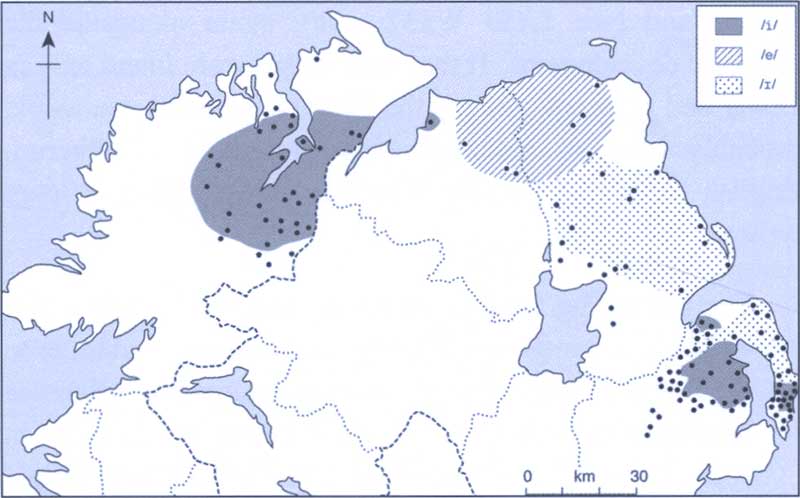
Vowel 7, reflexes of /ø/
The Ulster reflexes of Vowel 7 appear to reflect a mixture of source dialects. Map 5, based on Gregg (cf. LAS3 Map W150), shows the forms of abuin 'above'.(56) We find /əbin/ in south Down and Donegal, /əben/ in north Antrim and Londonderry, and /əbɪn/ elsewhere. As noted above, /əbin/ appears to have its origin in South-West Scots (Map 2). It appears that unrounding to /i/ dates back to the late 15th century in the North-East of Scotland,(57) but there is no indication of the date of unrounding in the South-West. As Gregg points out,(58) the /i/ areas were planted early and are further removed from contact with Scotland (in the case of county Down, from the ports of Donaghadee and Bangor), so this is probably the most archaic (surviving) form, undergoing replacement by /ɪ/.(59)
Apart from relics of /i/, /əbɪn/ is now the SVLR-short outcome in the South-West as well as in West Central and southern East Central Scots, so its presence in Ulster is easily accounted for. The earliest evidence for a split between Vowels 15 and 4 dates from 1635 for /ɪ/ and 1674 for /e/ in West Central.(60) In the South-West, LAS3 indicates that this /ɪ/ generally remains separate from Vowel 15, the latter as [ɛ̈]. In Ulster too, LAS3 sometimes shows this distinction in at least some environments (cf. 29.4 Ballyhalbert, 30.4 Cashel, 30.5 Kells). Gregg found merger with Vowel 15 only sporadically for certain items, and as the normal outcome only for a single county Down speaker.(61)
The form /əben/ is found in Lowland Scots in northern East Central, not a significant source of migration. Unrounding to /e/ can be dated to the end of the 16th century, but contemporary evidence is scant.(62) Gregg suggests that Ulster-Scots /e/ is a local development from /ɪ/, citing an [e] realisation of unstressed /ɪ/.(63) The remaining possibility is that the unrounding to /e/ is an independent development in Ulster, from an earlier /ø/.(64) Given the early date of settlement, it is likely that unrounding was incomplete in some of the source dialects, as it still is in LAS3 data for Southern Scots. Even in Edinburgh, some words apparently retained /ø/ [ø, y] as late as the 1870s.(65) The /əbun/ form of abune (sporadically on the periphery of Ulster-Scots in Gregg's data: see Lists and Map p. 82) is a spelling pronunciation.
A split to merge with Vowel 15 in short environments and Vowel 4 in long environments must follow the establishment of the SVLR, but SVLR does not mean that there has to be a split: this depends rather on a phonetic distance between the long and short allophones. An independent unrounding to /e/ in all environments could have taken place at any point. An independent interaction with SVLR is also a possibility. In both the localities that show /e/ for abuin in LAS3 (30.2 Ballymoney, 30.3 Lavan), the vowel is long, as are several other vowels in this environment. Gregg's 1985 lists provide further lexical items taking /e/, mainly also before /n/, but also before /l/ (Antrim 3 and 4 school , Londonderry 1 and 3 school and stool), which again tends to be an additional lengthening environment. However, /e/ also occurs rarely in just (Antrim 1 and 2) and good (Londonderry 3). Elsewhere, /e/ in abuin coexists with /ɪ/ in good. Some data, then, point towards a split, as in West Central Scots, but with an independent allocation of long and short environments; other data is towards /e/ throughout.
Map 6: unrounded and rounded reflexes of Vowel 12 in eastern Ulster-Scots (based on Gregg, 1985: Lists)
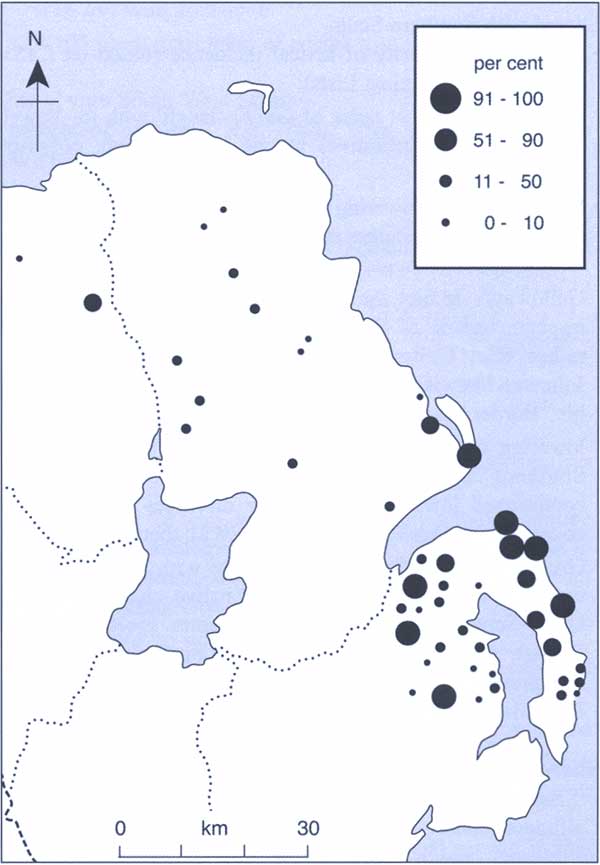
Vowel 12 /ɑ/ or /ɔ/
The reflex of Vowel 12 as in cause is predominantly unrounded in most of the Ulster-Scots area (and merged with Vowel 17 as in cat), but almost all points show some rounded forms, and the predominant form is rounded in a small area around Belfast Lough, with a finger stretching south down the main Belfast-Downpatrick route (as well as an isolated occurrence in county Londonderry) (see Map 6). This could represent a mixed input: /ɔ/ is the present West Central form, and /ɑ/ occurs in most of the South-West. However, the geographical configuration suggests that it is a later importation from Scotland. The date of the rounding in Lowland Scots is uncertain.(66)
The hypothesis of a later intrusion of /ɔ/ would perhaps explain Ulster-Scots form 'farm'.(67) Gregg must have been uncertain how to interpret this, as he departs from his usual practice of mapping all Ulster-Scots forms against all English forms, and maps form separately. It occurs on the edges of the Ulster-Scots area, almost entirely in the county Down, and appears to confirm Trudgill's point that in situations of dialect contact, interdialect forms arise that are derivable from neither variety.(68) It must be a local development of Scots or English farm (Ulster-Scots otherwise has the more usual Scots ferm).
| Figure 1: Possible development of farm to form | |||
| Stage 1 → | Stage 2 → | Stage 3 → | Stage 4 |
| Older Scots | Ulster-Scots | co. Down | |
| Vowel 17 [a ~ ɑ] | Vowel 17/12 [ɑ] | Vowel 12 [ɑ ~ ɔ] | Vowel 12/18 [ɔ] |
| farm | farm | *faurm | form |
Figure 1 suggests a possible route from farm to form. As we saw, unrounded Vowel 12 is merged in Ulster-Scots with Vowel 17 as [ɑ, a]. When rounded Vowel 12 /ɔ/ was introduced, an erroneous /ɔ/ form of farm was created. The situation is further complicated by the fact that /ɔ/ already existed as the realisation of Vowel 18 (as in cot, cord) in some environments, including before /r/. The lexical membership of /ɔ/ is unstable in this environment, and overlaps with the membership of /o/, but overall it appears that /o/ represents Vowel 5 (as in before) plus part of the inventory of Vowel 18, which has partly merged with it (see above), while /ɔ/ represents a residue of Vowel 18 (with not infrequent captures of Vowel 5). Hence the spellings in <o>, appropriate to Vowel 18. The confused state of the lexical inventories is illustrated in Table 3, which takes the LAS3 data for one Ulster-Scots locality and adds the historical vowel numbers.
There are some other isolated captures or transfers of lexis from Vowel 17 to rounded Vowel 12, for instance in work noun (Scots wark) in a single county Antrim locality (LAS3 Map W77). This word also has Vowel 12 in Central and Southern Scots (CSD), presumably originating by reinterpretation in dialects adjacent to the area where Vowel 17 merges with Vowel 12 as [ɒ] (see Map 3). Another Ulster example may be the change of marrow 'a match, to exchange help with agricultural tasks' to morrow (CSD, CUD).(69)
Vowel 3 /i/ or /e/
In Ulster-Scots, Vowel 3 is normally merged with Vowel 2 as /i/, not, as in Hiberno-English, with Vowel 4 as /e/. There are lexical exceptions as in Central Scots, but also unexpected /e/ forms, linking up with a cluster of /e/ localities in Wigtownshire and adjacent parts of Kirkcudbrightshire and Ayrshire (see Map 7).
Map 7: /e/ reflexes of Vowel 3 in the South-West of Scotland (based on LAS3 lists)
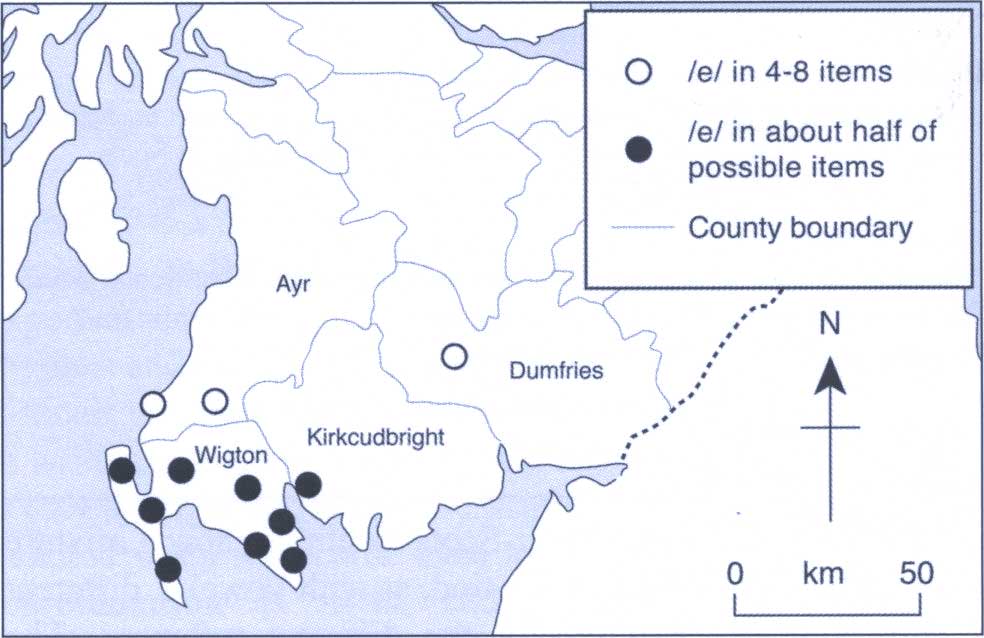
Notes: other localities in Kirkcudbrightshire, Dumfriesshire, south Lanarkshire and Roxburghshire frequently have /e/ in meal 'repast', and occasionally in other items.
At first sight, it would be tempting to interpret these forms, on both sides of the Irish Sea, as intrusions from Hiberno-English. However, Milroy argues that the /e/ variants are native to Ulster-Scots, originating in South-West Scots.(70) He points to /e/ forms in words such as head and deaf in East Ulster, which do not occur in Hiberno-English, because of shortening in English (see also above), but do occur in Wigtownshire. As it happens, neither LAS3 nor Gregg 1985 records /e/ in such words in rural Ulster-Scots, although two of LAS3 's Hiberno-English localities have /e/ in lead noun.(71) Gregg does not give complete data for Vowel 3 words, but he evidently expected /e/ in some items where it is not general in Scots (e.g. beak, beast, cheat, cream, Easter, neat, reaper, treat in List 10), but did not report the results. The LAS3 data are set out in Table 2.
| Table 2: /e/ in Vowel 3 in South-West Scots and Ulster-Scots (based on LAS3 Lists) | |||
| neither | both | South-West only | Ulster only |
| sweat | cheat | head | meat |
| lead v. | pear | bread | heat |
| swear | bear v. | dead | wheat |
| steam | heap | lead n. | tea |
| east | cream | thread | pea |
| speak | fear | pease | |
| meal (repast) | wear | leave | |
| steal | mare | breathe | |
| lean adj. | please | beak | |
| peace | deave | break*** | |
| beast | dream | meal (flour) | |
| aneath* | leak** | bean | |
| yeast | beal | mean | |
| creash | clean | ||
| leaf | |||
| deaf | |||
| least | |||
| Notes: | |||
| Italicised items take /ɛ/ in Standard English. | |||
| /e/ also occurs in the following words: beat, great, flea, bear n., beard, cheap, weak, heal, deaf, breath. These have /e/ generally in Scots. | |||
| No /e/ forms occur for knead or tread (Scots /ɛ/) or hear, reap, seal v., scene (Scots /i/). | |||
| * aneath has an uncharacteristic distribution in South-West Scots, being found only in a small cluster of localities in Kirkcudbrightshire and Dumfriesshire (see LAS3: map W160). | |||
| ** leak also has /ɛ/ in Scotland and Ulster; cf. break. | |||
| *** break usually has /ɛ/ in Scots. | |||
All of LAS3 's eight Ulster-Scots localities show a mixture of /i/ and /e/ forms. We do not find, as with Vowel 7, different geographical distributions for the different reflexes. The impression is of a complex ebb and flow of influences, with Hiberno-English perhaps reinforcing the adoption of some /e/ forms from the original mixture of inputs, and later reinforcing the survival of forms such as tea (universal in the LAS3 data for Ulster-Scots, but absent in Wigtownshire). Conversely, deaf with /i/ has spread into Hiberno-English (LAS3 Map W159).
| Table 3: Overlapping lexical incidence of Vowels 17/12, 12/18 and 5 before /r/ in Ulster-Scots (data from LAS3 Lists: 29.1 Newtownards, county Down). The numbers after the lexical items indicate the vowels to which they historically belonged. | |||
| LAS 3 phoneme | Historical phoneme(s) | Lexical incidence | |
| ɑ̈ | 17 a + 12 ɑ | barn (17), barrel (17), barren (17), dark (17), far (17), hard (17), sark (17), war (17), waur (12), work n. (17), work v. (17)* | |
| ɔ | 18 ɔ + 12 ɔ | fourth (5), hoarse (4)**, horse (18), north (18), sort (18), where (12) | |
| o | 5 o | before (5), boar (4)**, bore (5), born (18), corn (18), horn (18), port (18), storm (18), worn (18) | |
| Notes: | |||
| * By analogy with the noun. Also in Shetland (CSD). The verb is historically wirk. | |||
| ** Anglicised forms. | |||
Vowel 1: Additional Constraints on the Distribution of /aɪ/
Gregg(72) detected additional constraints in Ulster-Scots on the distribution of the lowered reflex of Vowel 1, as follows:
1. before voiced fricatives, weak verbs show the expected lowered reflex /aɪ/, e.g. arrive, dive, revise, prise; but strong verbs show unexpected /əi/, e.g. drive, rise, strive, thrive ;
2. following /ɪ/
əi does not go to aɪ in any type of S[cotch]-I[rish] if the preceding segment is w. Thus letter 'y' is called wəi, and 'wise' is wəiz, even in spite of the final voiced fricative z. The forms wəiər 'wire', ... 'choir' / 'quire', ... 'inquire', ... 'require', ... 'Maguire', show the same constraint, these latter being conspicuously deviant from the norm whereby the diphthong always precedes r, but is separated therefrom by a transitional ə, for example: dɑɪər 'dire', ... .(73)
We shall consider these in turn.
Map 8: /əi/ reflexes of Vowel 1 before /v, z/

Drive, rise
LAS3 does not include any weak verbs in the relevant environment (before the voiced fricatives /v, z/), so Gregg's hypothesis cannot be tested for Lowland Scots. However, the strong verbs drive and rise do figure in the LAS3 data, allowing us to say that there are areas around the periphery of Central Scots where /əi/ occurs in these two words (sometimes with the analogical addition of raise and drove verb), but not in other Vowel 1 words in the same environment (see Map 8), which is at least consistent with Gregg's interpretation of Ulster-Scots, though Aitken's pronunciation entries in CSD give no indication of unexpected /əi/ in strive or thrive. The geographical distribution of /əi/ forms of drive and rise in Lowland Scots suggests the remnant of a once-wider distribution, as does the larger penumbra of localities with /əi/ before /v, z/ in a wider range of vocabulary. At the time of the formation of Ulster-Scots, then, there may have been a more widespread retention of the conservative /əi/ form in the voiced fricative environment, but a predominance of the drive/rise pattern in the input dialects. As Gregg suggests, this retention may be owing to the influence of other /o/ preterite verbs such as ride and write.(74) The analogy appears to have been taken further in Ulster-Scots and to have become systematised there into a grammatical constraint with the addition of other strong verbs. Particularly telling is Gregg's observation that thrive 'will always retain əi when the past tense is θro:v, but with speakers who have moved this verb into the weak class, θrəiv at the same time shifts to θrɑiv (past tense θrɑivd)'.(75)
Wise, wire, why
The discussion of unexpected /əi/ following /w, ʍ/ is fraught with complications, as the lexical items involved often admit of other explanations. We must dismiss wise, for instance, for which the usual Scots form is wyce /wəis/. This is Gregg's only instance before a voiced fricative.
Many of the relevant items have following /r/, which is itself a conservative environment over large parts of the Lowlands, including much of Southern Scots (see Map 9). The only item in LAS3 with both preceding /w, ʍ/ and following /r/ is wire. Apart from Ulster-Scots, the localities where wire has /əi/ are within or peripheral to the area where /əi/ is the normal reflex before /r/ (see Map 9),(76) suggesting that the preceding /w/ is of little significance in Lowland Scots, if any.(77)
Gregg's morpheme-final examples are y (the letter) and why. The former seems to be peculiar to Ulster-Scots (it is not mentioned in SND s.v. y). In the 1973 article, he offers an alternative explanation for the latter, grouping it with a number of /əi/-final words that belong to Standard English as spoken in the Ulster-Scots area rather than to Ulster-Scots proper, e.g. die /dəi/ (Scots dee /di/). Presumably the confusion arose because the English model did not distinguish between the two diphthongs and therefore offered no guidance as to which was appropriate in these words. The surprising thing is not that such a confusion should have occurred (cf. the 18th century interdialectal forms of Scottish Standard English discussed in Macafee,(78) on the basis of data from Jones, inter alia), but that the interdialectal forms should have persisted. Why /ʍəi/ was found in 18th-century Scottish Standard English, on the evidence of 'Aulaxaunder Scoat'.(79)
Map 9: /əi/ reflex of Vowel 1 before /r/ based on LAS3: Lists
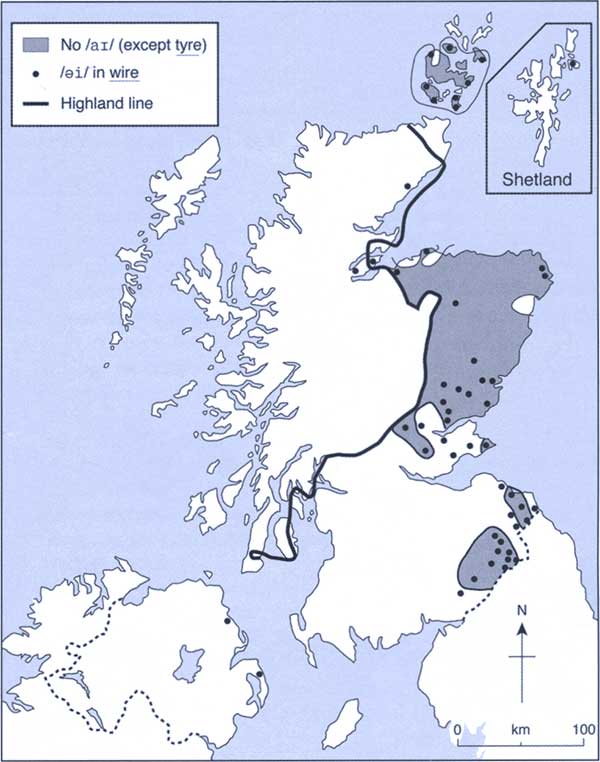
Note: in much of the North, wire takes the form weer with /i/.
LAS3 has only two words where morpheme-final Vowel 1 is preceded by /w, ʍ/. One of these, quey, we must dismiss, as its regular development to /kwəi/ throughout most of the Lowland Scots area (apart from North-Eastern quoy) suggests its early capture by Vowel 8, and indeed it appears with Vowel 8 items in the LAS3 questionnaire.(80) The remaining item is why. LAS3 shows several clusters of /əi/ in why (see Map 10). Some of these are in the peripheral areas that we have already seen linked with Ulster-Scots, but another is centred on Fife. In the North-East, possibly because of greater confidence in the use of Scots, the interviewees tended to translate why as Scots foo. Gregg similarly regards why as the English for what for.(81) If why /ʍəi/ is indeed an English (or rather interdialectal) intrusion into some Scots dialects, this presents a very interesting situation, for the word why certainly existed in Older Scots (CSD s.v. why). Of the replacement terms, hoo is recorded in this sense only from the 17th century, North-Eastern foo from the 19th, what for and what way from the 18th (CSD). Yet, if Gregg's interpretation is correct, these colloquial forms completely replaced the older word in Ulster and in much of Scotland north of the Forth, indicating the extent and rapidity of the restriction of Scots to colloquial registers. However, the distribution in Lowland Scots is also compatible with the interpretation that /ʍəi/ is an archaism.
Map 10: /əi/ reflex of Vowel 1 in why, based on LAS3: Lists
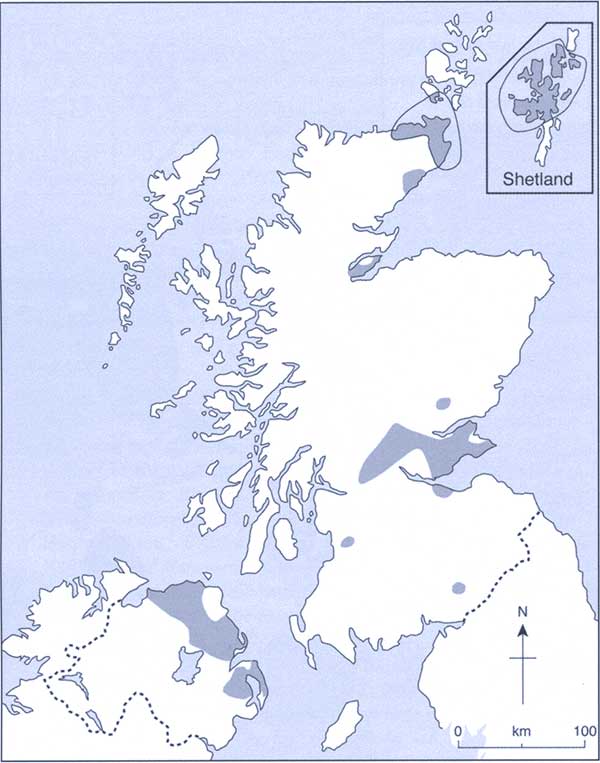
Note: In the North-East, the reply foo was usual.
For the preceding /w, ʍ/ environment, then, the evidence is inconclusive, but points to the apparent constraint in Ulster-Scots being a recent development, consisting mainly of /w, ʍ/ in combination with following /r/, this perhaps being the most conservative /r/ environment in Lowland Scots also.
Conclusion
Ulster-Scots was formed at a period when Lowland Scots was undergoing important phonological changes, whose effect was to increase the differences amongst regional dialects. The patterning of variation within Ulster-Scots suggests that some dialect differentiae reflect variation in the sources, while others may have diffused to Ulster-Scots later. The variants found in Ulster-Scots can sometimes be useful in reconstructing the history of the source dialects. As we have seen, the combined data of Gregg (1985) and LAS3 give us a detailed picture of the sources of phonological variation in the dialects of Ulster-Scots, but there still remain mysteries to be solved.
Notes
(1) Gregg, Robert J., 'The Scotch-Irish Dialect Boundaries in Ulster' in Wakelin, Martyn F. (ed.), Patterns in the Folk Speech of the British Isles (London: 1972), 109-139; Gregg, Robert J., The Scotch-Irish Dialect Boundaries in the Province of Ulster (Port Credit, 1985).
(2) Gregg, op. cit. (1985).
(3) Mather, James Y., and H. H. Speitel, The Linguistic Atlas of Scotland. 3 volumes (London, 1975, 1977, 1986).
(4) Johnston, Paul, 'Regional Variation' in Jones, Charles (ed.), The Edinburgh History of the Scots Language (Edinburgh, 1997), 443-513; Milroy, James, 'Some Connections between Galloway and Ulster Speech', Scottish Language 1 (1982), 23-29.
(5) The polyphonemes are symbolised by capital letters, but this convention is used in a different way by Catford, and, following him, Johnston, to symbolise vowels additional to the basic system. Catford, J. C., 'Vowel Systems of Scots Dialects', Transactions of the Philological Society, 107-117.
(6) †Aitken, A. J., The Older Scots Vowels: A History of the Stressed Vowels of Older Scots from the Beginnings to the Eighteenth Century, Caroline Macafee (ed.), (Scottish Text Society, n.p., 2002); Johnston, op. cit.
(7) Murray, J. A. H., The Dialect of the Southern Counties of Scotland (London, 1873).
(8) Grant, William, 'Introduction', The Scottish National Dictionary (Edinburgh, 1931).
(9) Johnston, op. cit.
(10) Aitken, A. J., 'Scottish Accents and Dialects' in Trudgill, Peter (ed.), Language in the British Isles (Cambridge, 1984), 94-114; Speitel, H. H., 'The Geographical Position of the Scots Dialect in Relation to the Highlands of Scotland' in Benskin, Michael, and M.L. Samuels (eds.), So Meny People, Longages, and Tonges: Philological Essays in Scots and Mediaeval English Presented to Angus McIntosh (Edinburgh, 1981), 107-129.
(11) Speitel, H. H., and James Y. Mather, 'Schottische Dialektologie' in Schmitt, L. E. (ed.), Germanische Dialektologie: Festschrift für Walter Mitzka (Wiesbaden, 1968), 520-541.
(12) Riach, W. A. D., 'A Dialect Study of Comparative Areas in Galloway', Scottish Literary Journal Supplement 9 (1977), 1-16; Supplement 12 (1979), 43-60; Scottish Language 1 (1980), 13-22.
(13) Milroy, op. cit., 28.
(14) Macafee, Caroline, Traditional Dialect in the Modern World: A Glasgow Case Study (Frankfurt, 1994).
(15) Knowles, G. O., 'The Nature of Phonological Variables in Scouse' in Trudgill, Peter (ed.), Sociolinguistic Patterns in British English (London, 1978), 80-90.
(16) Aitken, A. J., 'How to Pronounce Older Scots' in Aitken, A. J., et al. (eds.). Bards and Makars: Scottish Language and Literature, Medieval and Renaissance (Glasgow, 1977), 1-21; †Aitken, op. cit. (2002); Macafee, Caroline, and A. J. Aitken, 'The Phonology of Older Scots' in Corbett, John, J. Derrick McClure and Jane Stuart-Smith (eds.), The Edinburgh Companion to Scots (Edinburgh, 2003), 138-169.
(17) Aitken, A. J., 'The Scottish Vowel Length Rule' in Benskin, Michael, and M. L. Samuels (eds.), So Meny People, Longages and Tonges: Philological Essays in Scots and Mediaeval English Presented to Angus McIntosh (Edinburgh, 1981), 131-157.
(18) Harris, John, 'English in the North of Ireland' in Trudgill, Peter (ed.), Language in the British Isles (Cambridge, 1984), 115-134; Harris, John, Phonological Variation and Change. Studies in Hiberno-English (Cambridge, 1985).
(19) Aitken, op. cit. (1981).
(20) Gregg, Robert, 'The Diphthongs əi and ɑɪ in Scottish, Scotch-Irish and Canadian English', Canadian Journal of Linguistics 18 (1973), 136-145.
(21) Johnston, op. cit.; †Aitken, op. cit. (2002), §14.5.
(22) Mather, James Y., 'The Dialect of the Eastern Borders', Scottish Literary Journal Supplement 12 (1980), 38-42.
(23) Gregg, op. cit. (1985), 5.
(24) Gregg, op. cit. (1985), 50.
(25) Macafee, Caroline, 'Scots and Scottish English' in Hickey, Raymond (ed.), Legacies of Colonial English (Cambridge, 2004), 59-81.
(26) Kohler, K. J., 'A Late Eighteenth-Century Comparison of the "provincial dialect of Scotland" and the "pure dialect"', Linguistics 23 (1996), 30-68; Abercrombie, David, 'The Accents of Standard English in Scotland' in Aitken, A. J., and Tom McArthur (eds.), Languages of Scotland (Edinburgh, 1979), 68-84.
(27) Gregg, op. cit. (1985).
(28) †Aitken, op. cit. (2002), § 16.1.
(29) Johnston, op. cit.
(30) Gregg, op. cit. (1985).
(31) Gregg notes that some speakers have /ɔ/ in these words but not in other Vowel 12 items, and regards this as a local development, but this seems unnecessary given the Lowland Scots precedent; see Gregg, op. cit. (1985), 56.
(32) This word has extremely varied outcomes in Scots, but the other forms lacking expected Vowel 10 can probably all be referred to an underlying Vowel 7.
(33) Milroy, op. cit., 24.
(34) †Aitken, op. cit. (2002), 23.
(35) Macafee, Caroline, 'The Impact of Anglicisation on the Phonology of Scots: a Keethin Sicht' in Lenz, Katya, and Ruth Möhlig (eds.), Of dyuersitie & chaunge of langage. Essays Presented to Manfred Görlach on the Occasion of his 65th Birthday (Heidelberg, 2002), 240-256.
(36) The distinction between fir and fur is not always maintained.
(37) Milroy, op. cit., 25.
(38) Johnston, op. cit.
(39) Petyt, K. M., The Study of Dialect: An Introduction to Dialectology (London: 1980).
(40) Millar also identifies a body of lexis in CSD which has a distribution down the East Coast and also in the North, the South-West and often Ulster, but this is a wide grouping that takes in much of the Scots-speaking area; Millar, Robert McColl, 'Some Geographic and Cultural Patterns in the Lexical/Semantic Structure of Scots', Northern Scotland 18 (1999), 55-65.
(41) Johnston, op. cit., passim.
(42) For instance, Johnston, op. cit., 447.
(43) Collins, E. J. T., 'Migrant Labour in British Agriculture in the Nineteenth Century', The Economic History Review , 2nd series, 29 (1976), 38-59.
(44) Johnston (op. cit., 63) suggests that there may have been 'a seventeenth-century koiné of some kind, possibly a maritime one which would spring up in sailor and fisher communities', but this is mere speculation.
(45) Bell, Jonathan, 'Donegal Women as Migrant Workers in Scotland', Review of Scottish Culture 7 (1991), 73-80.
(46) Mather, James, Y., 'Linguistic Geography and the Traditional Drift-Net Fishery of the Scottish East Coast' in Wakelin, Martyn F. (ed.), Patterns in the Folk Speech of the British Isles (London. 1972), 7-31.
(47) Gregg, op. cit. (1985), 4, 5.
(48) Trudgill, Peter, Dialects in Contact (Oxford, 1986); Britain, David, and Peter Trudgill, 'Migration, Dialect Contact, New Dialect Formation and Re-allocation: Canadian Raising in England' Transactions of the Philological Society 97 (1999), 245-256.
(49) Gregg, op. cit. (1985), 4, 5; Johnston, op. cit., 489; †Aitken, op. cit. (2002).
(50) Johnston, op. cit., 489.
(51) †Aitken, op. cit. (2002), § 10.
(52) Adams, G. Brendan, 'Patterns of Word Distribution', Ulster Folk Life 2 (1956), 6-13.
(53) An etymology from Irish has also been suggested; cf. Adams, op. cit., 10.
(54) I am grateful to Marace Dareau for providing me with then unpublished DOST materials.
(55) †Aitken, op. cit. (2002), note 51.
(56) Gregg, op. cit. (1985), list 2, item 48.
(57) Dieth, Eugen, A Grammar of the Buchan Dialect (Cambridge, 1932).
(58) Gregg, op. cit. (1985), 49.
(59) Gregg, Robert J., 'Linguistic Change Observed: Three Types of Phonological Change in the Scotch-Irish Dialects' in Rigault, André, and René Charbonneau (eds.), Proceedings of the Seventh International Congress of Phonetic Sciences. Held at the University of Montreal and McGill University 22-28 August 1971 (The Hague/Paris, 1972), 723.
(60) Grant, William, and James Main Dixon, Manual of Modern Scots (Cambridge, 1921), §151. Since the earliest evidence of unrounding to /ɪ, e/ is from the West of Scotland, and there is late evidence for a rounded vowel in Edinburgh (see below), the innovation may have spread from West Central Scots, pace Gregg, 'Linguistic Change' (1972), 722.
(61) Gregg, op. cit. (1985), 49-51; words such as foot with /ɪ/ already in Middle Scots are a different case (see above).
(62) †Aitken, op. cit. (2002), §7.1.
(63) Gregg, op. cit. (1985), 50.
(64) LAS3 shows a number of cases of a rounded realisation in Ulster Scots, but it is unlikely that these represent the survival of original rounded Vowel 7. For instance Kells (Antrim 5) has [ɣ̈] before /f/ (luif palm of the hand', roof), and this is also the realisation of Vowel 15 before /x/ (bright, etc.) In other cases, we have to suspect a fronted /u/ Vowel 6, representing the Standard English form, e.g. [y] in Ballymoney boot, too, etc. and /ø/ in Ballywalter cure, moor, although the possibility of survival cannot be entirely discounted.
(65) Ellis, Alexander, On Early English Pronunciation, volume 5 (London, 1889), as cited Kohler, op. cit., and Speitel, H. H., 'An Early Specimen of Edinburgh Speech', Work in Progress, Department of Phonetics and Linguistics, University of Edinburgh 3 (1969), 26-36.
(66) Discussed further in Macafee, op. cit. (2002).
(67) Gregg, op. cit. (1985), Map 160, also Map p. 83.
(68) Trudgill, op. cit.
(69) Another intriguing case is that of whan (LAS3 W152 when). This map illustrates very well the weaknesses of the 'polyphoneme' system of presentation. A small number of localities in southern Scotland and one in north county Antrim are shown as having O. Phonetically O can be, for instance, [ɑ, ɔ, o]; phonemically it can be Vowel 17 (which may be merged with Vowel 12), Vowel 12, Vowel 5 (which may be merged with Vowel 18) or Vowel 18. In this case, it is most of the above. The impression of uniformity conveyed by the mapping of O is wholly misleading. In Lanarkshire and Berwickshire, it represents regular Vowel 17 whan, but merged with Vowel 12. Kirkcudbrightshire 1 has Vowel 12. A cluster of three localities in southern Dumfriesshire and Roxburghshire have Vowel 5/18 (apparently a unique survival of quhone, which is thought to have disappeared in the early 16th century). Which of these possible inputs, if any, is responsible for [ɔ] (Vowel 12? Vowel 18?) in county Antrim is anybody's guess.
(70) Milroy, op. cit., 24.
(71) The relevant LAS3 maps (W21, W22) are systematically misleading, showing Hiberno-English /ɛ/ forms and Wigtownshire /e/ forms both as 'E'.
(72) Gregg, Robert, 'Notes on the Phonology of a County Antrim Scotch-Irish Dialect. Part 1: Synchronic Phonology', Orbis 7 (1958), 392-406; Gregg, op. cit. (1973); Gregg, op cit. (1985).
(73) Gregg, op. cit. (1973), 141.
(74) Gregg, op. cit. (1985), I, 21.
(75) Gregg, op. cit. (1973), 139-140.
(76) Ibid.
(77) The item tyre is often an exception, having /aɪ/ in many localities where /əi/ is otherwise general before /r/. The word did not occur in Older Scots, and appears to be a recent loan from Standard English, hence the irregular phonology.
(78) Macafee, op. cit. (2004).
(79) The Contrast (1779), reproduced and discussed in Jones, Charles, A Language Suppressed. The Pronunciation of the Scots Language in the 18th Century (Edinburgh, 1995), Table 7.1, Appendix 1.
(80) In LAS3, /kwae/ occurs in a few Roxburghshire localities, once in Morayshire, and in Orkney. CSD records it more widely, adding southern East Central and West Central.
(81) Gregg, op. cit. (1973), 141.

